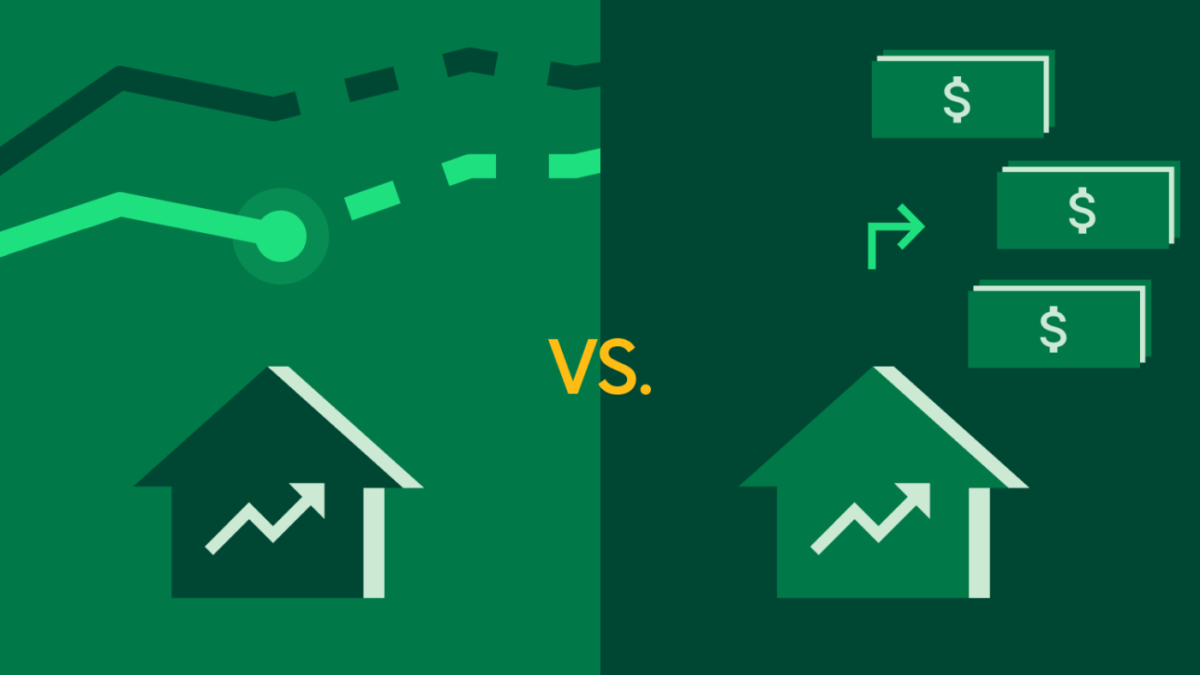
What Is a Refinance vs. a Cash-Out Refinance
If you have purchased a home with a mortgage, you have the option to refinance your loan. Maybe you want to refinance for a better interest rate to lower your required monthly payment. Perhaps you have a more lucrative job now and want to shorten the term of your loan. Increasing your monthly payment and paying your mortgage off sooner will result in paying less interest over the course of the mortgage, potentially saving you thousands of dollars over the life of the loan. Maybe your credit score has increased after paying off some credit card debt or after paying off your auto loan and now you may qualify for better terms on a new refinanced mortgage.
Another reason you may consider refinancing your home loan is to be able to cash out on some of the equity built up over the course of your homeownership. This is called a cash-out refinance. Home equity builds as you make payments against the principal of your mortgage or the value of your home increases. Using a cash-out refinance, homeowners can access that equity.
But how do a refinance and cash-out refinance differ? Which is right for you? Below, we discuss the differences between a refinance vs. cash-out refinance and the pros and cons of each option.
What Is a Rate-and-Term Mortgage Refinance?
A rate-and-term refinance is when you exchange your current mortgage terms with new terms. Rate-and-term refinance is the standard refinancing option most people consider when they’re looking to lower their interest rates or shorten or lengthen the time to repay the entirety of the home loan.
Refinancing your home loan is a great idea if you opted for an adjusted-rate mortgage and your lower interest rate is about to jump to a higher percentage. You can also choose to change your loan type from an adjusted-rate to a fixed-rate mortgage if the interest rates are looking beneficial.
Refinancing is also a great idea if you are able to get a lower interest rate on your mortgage due to either a personal change in financial status or increased credit score or if interest rates have dropped low enough to make the refinance process worth your while. Lowering your interest rate by just 1 percent could make a significant difference.
Another reason borrowers consider refinancing their mortgage terms is to remove private mortgage insurance (PMI). If you have at least a 20 percent equity on your home, most lenders no longer require borrowers to pay for PMI. Removing it could save you a significant amount on monthly payments. Refinancing a home loan also allows you to add or remove a borrower from your mortgage.
Rate-and-term mortgages are considered fairly easy to qualify for since you are not adding money to the loan amount, and so a lower credit score and income-to-debt ratios will be accepted.
What Is a Cash-Out Refinance?
If you are looking to borrow a large sum of money and can wait for a few weeks for the mortgage refinance process to be completed, a cash-out refinance may be a good option for you. With a standard refinance, the amount of your new home loan matches what you still owe on your original loan dollar for dollar. If you owe $150,000, your new loan is for $150,000.
The difference between a refinance vs. cash-out refinance is that with a cash-out refinance you can increase your loan amount by borrowing extra from the equity you’ve built up in your home. Since the amount available to borrow is based on the available home equity, a home appraisal will be required to assess the current home value prior to closing on the refinanced loan. When the new loan is used to pay off the original loan, the amount remaining is paid to you in cash.
Note that cash-out refinancing means you increase your debt, as you will be adding a lump sum of money on top of your previously borrowed mortgage amount. Since your home is your collateral, if you are unable to make the monthly payments, your home could be at risk for foreclosure. It’s important to weigh the risks against the benefits when deciding whether to borrow some of your equity.
Benefits of a Cash-Out Refinance
The primary benefit of a cash-out refinance over a standard refinance is the ability to borrow additional cash for large expenses, such as making home improvements or paying for school. But how does a cash-out refinance measure up to a personal loan, another way to get cash quickly? A cash-out refinance is often the better option.
Cash-out refinance loan interest rates tend to be lower than personal loans, for starters. Plus, with a cash-out refinance, you can still potentially lower your home loan interest rate even though you are adding to your loan. If interest rates have dropped significantly or your credit score has improved, for example, you can benefit from refinancing while also getting the cash you need.
In addition, the amount you are able to borrow through a cash-out refinance is much higher than a personal loan. So, if you are looking to borrow more than is available through other means, this may be a good option for you.
A cash-out refinance loan also means that you have just one payment to make a month instead of paying off a personal loan and a mortgage. When you refinance, all payments from that point on go toward the new loan (the original loan has been paid off), even when you’ve borrowed against your home equity and increased your loan through a cash-out refinance.
To see how much you could potentially borrow with a cash-out refinance, you can utilize a refinance calculator. If you would prefer to discuss your refinance vs. cash-out refinance options with a financial lender, a Home Loan Guide from Solarity Credit Union can answer your questions and walk you through the process.
